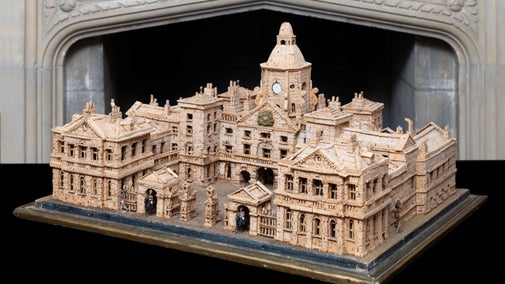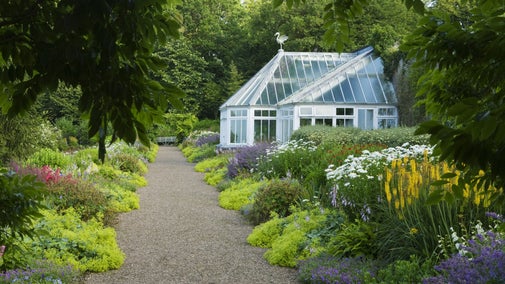
Arlington Court and the National Trust Carriage Museum's collections
Explore the objects and works of art we care for at Arlington Court and the National Trust Carriage Museum on the National Trust Collections website.

Over 11 generations of the Chichester family helped to shape the Arlington Court you see today. As well as their desire for building, the collections assembled throughout the years give a glimpse into their lives and passions. From pewter to shells and an unusual discovery, find out more about some highlights from the collection.
One of the most significant items in the collection is an original pen and ink drawing by William Blake. It is not known how the picture by the famous poet, artist and social critic came to be at Arlington, but its discovery was almost as mysterious as the image itself.
Legend has it that the framed picture was found on top of a wardrobe in the housemaid’s pantry when the National Trust acquired the house in 1949. It’s not known how long it rested there, but it is suspected to have been purchased direct from William Blake by Colonel John Chichester in the 1820s.
The picture is known as The Sea or Time and Space (Vision of the Circle of the Life of Man), which is a quotation from Blake’s work Prophetic Book Vala. The image was inspired by Greek mythology and could be taken from Homer’s Odyssey.
The image weaves classical imagery into an obscure narrative that seems to revolve around the theme of choice. Whilst various readings have been put forward, the broad consensus is that the kneeling male figure represents divine inspiration and imagination, while the standing female makes the case for the natural, or scientific, order of classical thought.
Whatever the precise meaning, the sea here appears to represent a positive direction for Blake as his male protagonist gestures towards the waves with an attitude of yearning and mysticism.
Discover more about this William Blake drawing on the National Trust Collections website
Sometimes described as ‘poor man’s silver’, pewter has been made into tableware and household items since the ancient Chinese and Roman periods some 2,000 years ago. Discover Arlington Court's pewter collection.
Miss Chichester, the last owner of Arlington Court, started to collect shells at an early age, sailing around with her mother and father on the family yacht, Erminia. When they anchored at port, a young Miss Chichester would be accompanied ashore, where she would look for interesting and colourful shells.
This was just the start of what would become a lifelong interest in collecting shells and anything to do with the sea. By the time she was an adult, Miss Chichester had collected a large number of shells and catalogued them with individual names. She displayed them in her own private museum, which was formerly the old dining room.
Arlington’s collection comprises around 3000 shells and includes some very rare examples that can no longer be found in our oceans. The cabinets around the house display a mixture of shells.
Look out for the 'Chambered' or 'Pearly' nautilus from the West Indies, and the Morning Room display laid out by Sir Edward Salisbury of the Natural History Museum in 1949, which includes some rare specimens from the Mediterranean, Indo-Pacific and Asian oceans.
Some of the other unique shells, like the 'Green' or 'Pearly' snail found in the China Seas and the Pacific, have been partly peeled and made into souvenirs; the work is most likely Chinese but could be Chinoiserie, a European style imitating the Chinese.
These are examples of the souvenir shell work mass-produced at seaside places in the 1860s when shell work began to be exploited for commercial purposes. These particular shells are displayed in the museum corridor.
Arlington is also home to many other treasures, with nearly 5,000 items in the collection. There is an extensive textile collection containing around 500 pieces, from elegant evening dresses and tablecloths to parasols and baby clothes. There's also a collection of model ships famous for its size and variety, with one boat no bigger than a 10p piece.
With such a large and varied collection, it is not possible to have everything on display. Access to the collection outside of normal opening hours can be arranged by appointment only.
To make an appointment to see a particular item, call 01271 850296 or email arlingtoncourt@nationaltrust.org.uk.

Explore the objects and works of art we care for at Arlington Court and the National Trust Carriage Museum on the National Trust Collections website.
The art and heritage collections we care for rival the world’s greatest museums. Learn more about the collection of paintings, decorative art, costume, books, household and other objects at historic places.

See the breadth of our collection of works of art, furniture and more: we care for around a million objects at over 200 historic places, there’s a surprise discovery around every corner.

The house at Arlington Court is the work of generations of the Chichester family. Discover how each heir left their mark on the building you see today.

Discover the stories behind some of the greatest artworks and artefacts looked after by the National Trust, as told in a dedicated book, 125 Treasures from the Collections of the National Trust.

Explore the evolution of carriages and their changing fashions, from the one with the disreputable image to the one with a royal seal of approval.

From the ever-changing flowers of the formal Victorian Garden to picture-perfect pleasure grounds, the garden at Arlington Court is beautiful whatever the weather. Step into the hidden walled kitchen garden for variety through the seasons.

Explore highlights from a collection of over 40 carriages, including those used for grand state occasions, fashionable funerals and travelling around Europe in style.
